History, meaning and kinds of tuna (maguro)
Various tuna and tuna dishes in Japan!?
A maguro sushi which means tuna sushi is very popular in Japan. When did Japanese start eating a tuna? It is said that Japanese ate it from 10,000 BC because a bone of tuna was discovered from shell mound (kitchen midden).
Japanese eat tuna for a long time, but they did not like it for a while in the past. Especially, the Samurai soldier disliked it because tuna was called Shibi-uo then. Shibi means death day, uo means fish. On the other hand, he liked a bonito (skipjack tuna) since it was called Katsuo. Katuo means a winner man.
Most ordinary Japanese began to eat and like it since Edo period (1603-1867). They began to use a soy sauce since former period or the same period. They found that a tuna with soy sauce was delicious, and it could be preserved by pickling in soy sauce. Sushi restaurants began to be popular in the same time. These restaurants served a tuna pickled in soy sauce called Zuke. Zuke was served by contemporary sushi restaurants in Japan.
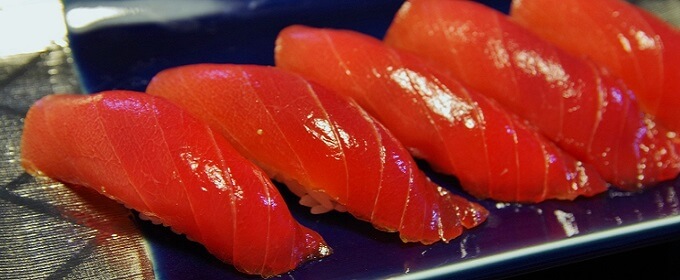
Toro which is fatty tuna was not popular then because it is not good for preserving. Toro was stewed with vegetables or thrown away then. It is said that toro was called "Neko-matagi" which meant that a cat strides over it.
A tuna became popular year by year, and a toro also became popular depending on the taste of Japanese changed. The New Year auction of tuna in Tsukiji market is broadcasted on TV from 2000s. The price of tuna in this auction is soaring in recent years. The highest tuna in 2019 was 333 million yen (about 3.33 million dollars). Kiyomura Co. which manages sushi restaurants "Sushi Zanmai" made a successful bid.
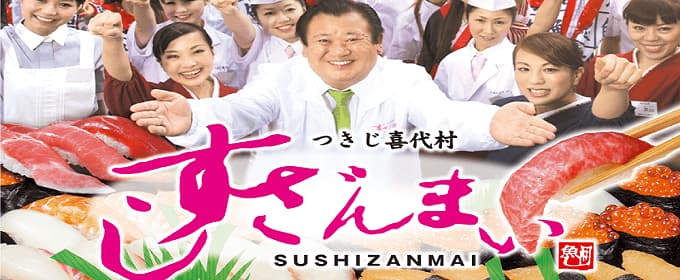
Mr. Kimura who is the CEO of this company is well known for decreasing pirates in Somalia. He gave ships and cold storage ware houses for pirates, and taught how to catch a tuna. He buys all tunas they caught because of keeping their lives steady.
The documentary TV program of fishermen in Oma town also became popular from 2000s. "Maguro-ni-kaketa-otokotachi" which means fishermen stake their lives on tuna had an average audience rating of 17.1% in 2006, about 10% in recent years. Some Japanese think this documentary is one of the highlights of the year.
Nowadays, Japanese eat 5 kinds of tuna, Pacific bluefin tuna, Southern bluefin tuna, Bigeye tuna, Yellowfin tuna and Albacore. Pacific bluefin tuna is called Kuro-maguro or Hon-maguro in Japan. It is known as highest quality tuna. It has the deep red meat and much toro (fatty part). It grows 300 kg (about 660 lb) for 10 years. It is caught in the sea Pacific coast of Japan, Oma city, Toi city, Matsumae city are famous for tuna fishery. In addition, wild-caught tuna is imported from Boston and Ireland.
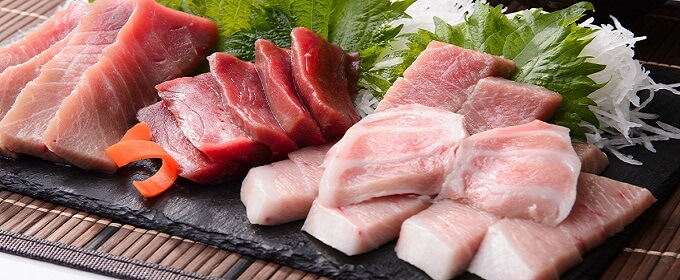
Southern bluefin tuna is called Minami-maguro or India-maguro in Japan. It is little smaller than Pacific bluefin tuna, but it is as good as Pacific bluefin tuna. Some sushi restaurants do not serve Pacific bluefin tuna but Southern bluefin tuna sushi because it has strong flavor. A Southern bluefin tuna is not sold in grocery stores in Japan.
Bigeye tuna is called Mebachi-maguro in Japan. It is smaller than Southern bluefin tuna, and its flavor is weaker than Southern bluefin tuna. It is most popular tuna in Japan because it has light taste and is reasonably priced. Most of it do not have toro (fatty part) since it is small. However, some of it caught in late autumn or winter has toro and overcome flavor of Southern bluefin tuna.
Yellowfin tuna is called Kihada-maguro in Japan. It is as big as Bigeye tuna, but it has weaker taste and is cheaper than Bigeye tuna. The amount of it assumed about 30% of total tuna consumption because of light taste and low price. Japanese in west of Japan eat it more than in east of Japan. The best season for it is summer.
Albacore is called Bincho-maguro in Japan. It is smallest and cheapest tuna in the 5 tunas. It is different from meat color in the 5 tunas, it has white pink meat. It is used for canned tuna for a long time, conveyor belt sushi restaurants began to serve it as sushi. These restaurants buy it by stable low prices because it is not put up for auction. Winter Albacore have plenty of fat, it is delicious in spite of low price. Fatty Albacore is called Toro-Bincho in Japan.
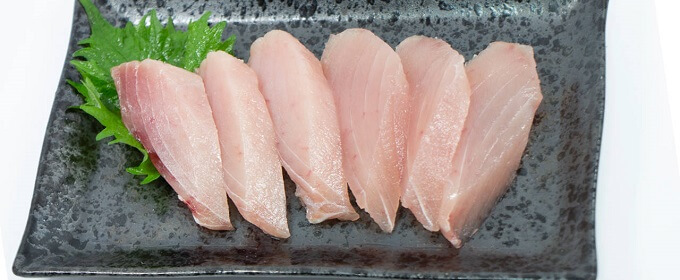
Japanese eat not only body of tuna but also other parts, gill meat, cheek meat, tail, eyes, skin and entrails. There is the proverb which says "There is no parts in tuna for throw away" in Japan. A gill meat called Kama in Japanese is a rare part because there is only 2 parts in one tuna. It is often eaten by grilling with bone because there is a thick bone near it. This part is juicy, but Kama-toro is juicier than this part. Kama-toro is a meat under the gill meat.
A cheek meat called Hoho-niku in Japanese is also a rare part because there is only 2 parts in one tuna. Its shape is like crescent moon, and taste is like meat. It is often eaten by grilling or skewer-grilling. A tail meat is cut in a round slice, and is also eaten by grilling. In addition, eyes are eaten by simmering with soy sauce, skin is eaten by boiling and seasoning, entrails are eaten by boiling or simmering.
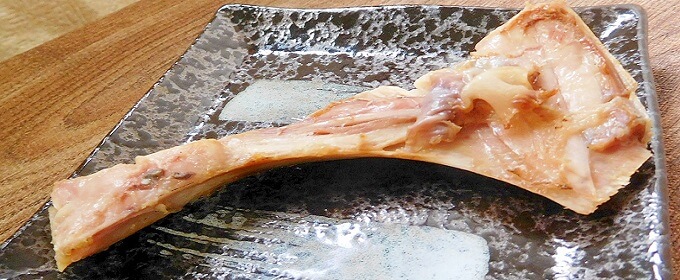
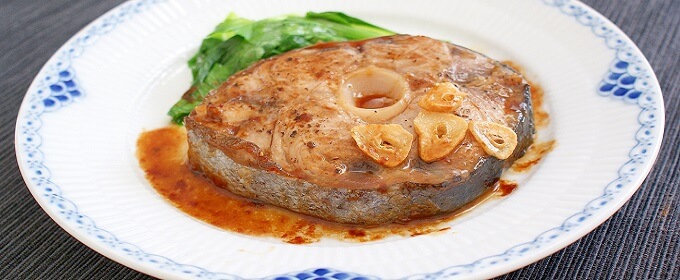
By the way, there are various tuna dishes in Japan though most popular tuna dish is sushi. Tekka-don which consists a bowl of rice topped with raw tuna slices is a Japanese traditional donburi dish. Maguro-yamakake consists raw tuna slices with grated yam. There are also tuna dishes cooked on fire, tuna steak (maguro-no-tataki), deep fried tuna (maguro-katsu, maguro-age), grilled tuna meat ball and more.
You can enjoy various tuna dishes including sushi when you travel Japan. If you like sushi and conveyor belt sushi restaurant, you can invest it. Food and life companies (TYO:3563) and Kura Sushi Inc (TYO:2695) are listed in Tokyo Stock Exchange. If you like Japanese tuna dishes, you can invest Kyokuyo Co. (TYO:3563) which is the largest fishery company in Japan. These companies are also included some ETFs for investing Japanese companies.
- Ikura and Sujiko are little different!?
- Shake means salmon, but they are different!?
- Various crab and crab dishes in Japan!?
- What is Kappa-maki and Kappa?
- Good-old sushi restaurants do not serve raw shrimp sushi!?
- Japanese eat various squid and squid dishes!?
- There are various toro, that is confusing!?
- Various tuna and tuna dishes in Japan!?
- There are various way to use wasabi!?
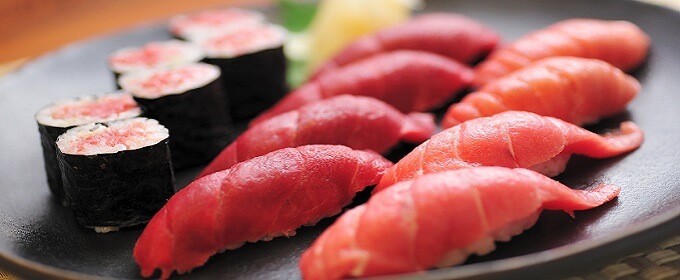
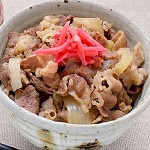 Gyudon
Gyudon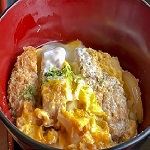 Katsudon
Katsudon Unadon
Unadon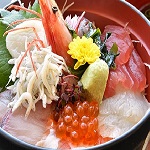 Kaisendon
Kaisendon